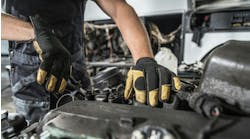As preliminary statistics indicate that trucking-related fatalities increased slightly in 2003 versus 2002, the industry is refocusing its safety efforts– especially truck driver seat belt usage. Not only would increased usage keep fatalities and injuries low but it would save money as well.
According to early numbers compiled by the National Highway Traffic Safety Administration (NHTSA), there were 4,942 truck-involved fatalities in 2003 – a 0.9% increase from the 4,897 deaths reported in 2002. Bill Graves, president and CEO of the American Trucking Assns. (ATA), points to a low level of seat belt usage by truck drivers – around 47% – as one major reason why fatalities may have increased.
“Of special concern to us is the number of solo truck drivers who died in crashes because they weren’t wearing their safety belt,” he said. “These deaths are preventable and unnecessary. We’ll continue to work within DOT Secretary Norman Mineta’s Safety Belt Partnership to address this serious issue.”
However, Dave Letke, director of safety for trucking conglomerate SCS Transportation of Kansas City, MO, told Fleet Owner that improving trucking safety can’t be done in a “one-size-fits-all” manner and must recognize both the human and cost-savings benefits that can be gained.
“There are various industry benchmarks you can measure yourself against, but at the end of the day, it’s difficult to benchmark against another company,” he explained. “Each trucking operation is different and they measure accidents differently than you do. We focus on our own trends, developing clear calculations that move us up the safety ladder.”
That’s especially true in SCS’ case as it operates two distinct subsidiaries: NJ-based Jevic Transportation, a $300-million LTL/TL hybrid that handles mostly heavyweight shipments for the chemical industry, and Georgia-based Saia Motor Freight, a $521-million multi-regional LTL carrier now serving 29 states mostly with one and two-day lanes.
Letke said that collectively SCS’s two subsidiaries reduced accidents by 12% and cut lost-time injuries by 13% from 2002 to 2003. In terms of monetary savings from those reductions, Jevic saw its accident/workman’s comp costs decline from 2.5% of revenue in 2002 to 1.6% in 2003; and Saia’s went from 1.9% to 1.2% of revenue.
“These are measurable results,” he said. “First of all, you must make safety the number one priority in the company, because the rest of the things you are trying to accomplish – profits and growth – will be difficult if not impossible to achieve unless you are safe. I hate to focus on costs here, but if you have to retrain and rehire because of injuries and accidents, you are talking about a significant cost to your operation.”
However, Letke stressed that dollar savings can’t be the ultimate goal for trucking safety efforts. “Our feeling is that everything we do at SCS should focus on the safety of our employees,” he said. “Despite the cost savings, we don’t have to justify our safety focus – it is just the right thing to do.”


